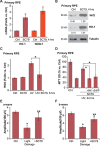SC79 protects retinal pigment epithelium cells from UV radiation via activating Akt-Nrf2 signaling
- PMID: 27517753
- PMCID: PMC5312373
- DOI: 10.18632/oncotarget.11164
SC79 protects retinal pigment epithelium cells from UV radiation via activating Akt-Nrf2 signaling
Abstract
Excessive Ultra-violet (UV) radiation causes oxidative damages and apoptosis in retinal pigment epithelium (RPE) cells. Here we tested the potential activity of SC79, a novel small molecule activator of Akt, against the process. We showed that SC79 activated Akt in primary and established (ARPE-19 line) RPE cells. It protected RPE cells from UV damages possibly via inhibiting cell apoptosis. Akt inhibition, via an Akt specific inhibitor (MK-2206) or Akt1 shRNA silence, almost abolished SC79-induced RPE cytoprotection. Further studies showed that SC79 activated Akt-dependent NF-E2-related factor 2 (Nrf2) signaling and inhibited UV-induced oxidative stress in RPE cells. Reversely, Nrf2 shRNA knockdown or S40T mutation attenuated SC79-induced anti-UV activity. For the in vivo studies, we showed that intravitreal injection of SC79 significantly protected mouse retina from light damages. Based on these results, we suggest that SC79 protects RPE cells from UV damages possibly via activating Akt-Nrf2 signaling axis.
Keywords: Akt; SC79; UV; retinal pigment epithelium.
Conflict of interest statement
None.
Figures






References
-
- van Lookeren Campagne M, LeCouter J, Yaspan BL, Ye W. Mechanisms of age-related macular degeneration and therapeutic opportunities. J Pathol. 2014;232:151–164. - PubMed
-
- Beatty S, Koh H, Phil M, Henson D, Boulton M. The role of oxidative stress in the pathogenesis of age-related macular degeneration. Surv Ophthalmol. 2000;45:115–134. - PubMed
-
- Young RW. Solar radiation and age-related macular degeneration. Surv Ophthalmol. 1988;32:252–269. - PubMed
-
- Cao G, Chen M, Song Q, Liu Y, Xie L, Han Y, Liu Z, Ji Y, Jiang Q. EGCG protects against UVB-induced apoptosis via oxidative stress and the JNK1/c-Jun pathway in ARPE19 cells. Mol Med Rep. 2012;5:54–59. - PubMed
MeSH terms
Substances
LinkOut - more resources
Full Text Sources
Other Literature Sources
Molecular Biology Databases
Miscellaneous

